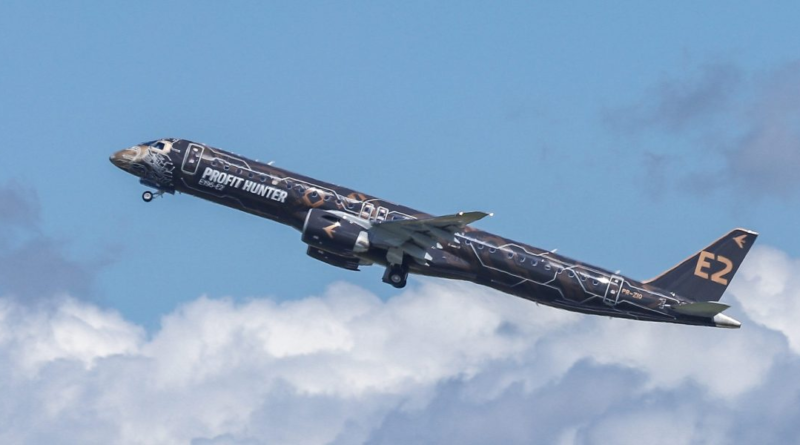Boeing’s weakness has a lesser known rival from Brazil gearing up to compete, and American Airlines’ CEO is a fan
While Boeing struggles with regulatory hurdles and delivery delays, a smaller competitor known for its regional and business jets may be raising its ambitions to compete—possibly at its own peril.
Brazil-based airplane manufacturer Embraer is reportedly exploring the idea of creating a next-generation narrow-body jet, the Wall Street Journal reported. Embraer’s new aircraft would take on Boeing’s 737 Max jets and Airbus’ A320 aircraft. It would mark the smaller company’s first attempt at direct competition against the two aerospace giants, which effectively control the market for planes with more than 130 seats.
Embraer’s ambitions picked up after a 737 Max operated by Alaska Airlines lost a panel in midair in January, sources told the Journal. That incident prompted U.S. safety regulators to limit Boeing’s production.
While Embraer denied reports that it would build a competing plane, a spokesperson told the Journal that it “certainly has the capability” to do so.
Embraer already has a cheerleader in American Airlines CEO Robert Isom, who complimented the manufacturer on the carrier’s quarterly earnings call last month. American’s fleet includes three types of Embraer Regional Jets, all with fewer than 100 seats.
“I want to give a shout out to Embraer,” he said. “They have delivered day in and day out, throughout the pandemic, no matter the concerns of their supply chain.”
When asked about delivery delays from Boeing, however, Isom had a different message: “Get your act together.”
Analysts at Bank of America led by Ronald Epstein echoed Isom’s sentiment, cheering on the possibility of Embraer taking a shot at the duopoly between Boeing and Airbus in a Friday note. The BofA analysts pointed out that between 1999 and 2019, Embraer was largely on time and on budget with its projects.
“They really are an engineering marvel,” they wrote. “Therefore, we have no doubt Embraer could develop an excellent jet to compete in the same class as the 737 Max and the A320neo, on budget, on time and at a fraction of the cost of the other OEMs (original equipment manufacturers).”
Morningstar equity analyst Nicolas Owens told Fortune that Embraer is one of a few, if not the only company, that could enter this market. But that doesn’t mean it will—or that it should.
Owens said that while Embraer is a capable company, it is a fraction of the size of Boeing and Airbus and would be overwhelmed by the incredible cost of designing a new plane, scaling up production, and then convincing exceptionally skeptical carriers to take a chance on the new model.
Embraer’s biggest plane at the moment, the E2, is smaller than the 737 and A320, and only about 100 of them have been produced since 2018, Owens said. Meanwhile, Boeing and Airbus are building 100 planes between them per month.
“Embraer has some of the know-how in terms of design and technology, but not the hands-on know-how of what it takes to scale up building an even-larger jet,” Owens told Fortune in an email. “I don’t know where they’d get the startup funds to launch this product that wouldn’t see revenue for almost a decade.”
Even the more optimistic analysts at Bank of America argued that Embraer would need to be creative to bring a competing plane to market, possible financing it through risk-sharing partners, direct investment by partners, or some other strategy. It would also have to deal with capital, geopolitical, and market access problems.
It was the latter of these issues that made the difference the last time a competitor tried to take a shot at Boeing and Airbus, explained Owens in an April note. After spending more than 10 years and billions of dollars launching an aircraft to compete with the duopoly, Canadian aircraft manufacturer Bombardier was forced to sell its CSeries jet at a steep loss to Airbus after Boeing petitioned the U.S. Department of Commerce to hit it with a tariff for selling the plane below production cost. Another example lies in Japanese conglomerate Mitsubishi, which last year folded a 16-year effort to develop a regional jet.
The newest company to take on Boeing and Airbus, the CCP-backed COMAC, still relies on many U.S.-based parts and has a long while before it can produce them at any sizable quantity, Owens said.
While Embraer’s ambitions are high, the reality of bringing a new plane to market may be too much to overcome, Owens wrote in a note for Morningstar.
“Boeing and Airbus are the only two capable suppliers of globally competitive aircraft larger than 130 seats, and we don’t see any globally competitive new entrants entering the market anytime soon,” he predicted.




